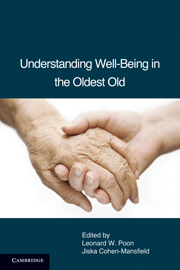Book contents
- Frontmatter
- Contents
- List of Tables
- List of Contributors
- Foreword by Carol D. Ryff
- PART I THEORY: NEW HORIZONS IN WELL-BEING RESEARCH
- PART II PARADISE LOST: BETWEEN TRAUMA AND HAPPINESS
- PART III PATHWAYS AND GATEKEEPERS: MODERATING, MEDIATING, AND PROXIMAL PROCESSES
- PART IV SIGNPOSTING PARADISE: MEASUREMENT OF WELL-BEING
- 15 Culture and Meaning: Strategies for Understanding the Well-Being of the Oldest Old
- 16 The Will to Live as an Indicator of Well-Being and Predictor of Survival in Old Age
- 17 The Measurement of Life Satisfaction and Happiness in Old-Old Age
- 18 Late-Life Psychotherapy: Challenges and Opportunities to Enhance Well-Being in the Oldest Old
- 19 An Integrative Summary and Future Directions in the Study of Well-Being
- Index
- References
16 - The Will to Live as an Indicator of Well-Being and Predictor of Survival in Old Age
Published online by Cambridge University Press: 05 August 2012
- Frontmatter
- Contents
- List of Tables
- List of Contributors
- Foreword by Carol D. Ryff
- PART I THEORY: NEW HORIZONS IN WELL-BEING RESEARCH
- PART II PARADISE LOST: BETWEEN TRAUMA AND HAPPINESS
- PART III PATHWAYS AND GATEKEEPERS: MODERATING, MEDIATING, AND PROXIMAL PROCESSES
- PART IV SIGNPOSTING PARADISE: MEASUREMENT OF WELL-BEING
- 15 Culture and Meaning: Strategies for Understanding the Well-Being of the Oldest Old
- 16 The Will to Live as an Indicator of Well-Being and Predictor of Survival in Old Age
- 17 The Measurement of Life Satisfaction and Happiness in Old-Old Age
- 18 Late-Life Psychotherapy: Challenges and Opportunities to Enhance Well-Being in the Oldest Old
- 19 An Integrative Summary and Future Directions in the Study of Well-Being
- Index
- References
Summary
ABSTRACT
The will to live (WTL) is presented in this chapter as an important indicator of general well-being due to its diagnostic and prognostic value. Conceptually, the WTL is defined as the psychological expression of a natural instinct of human beings – the striving for life, which is comprised of rational and irrational components, and can be self-assessed. The WTL can be measured by a single item or by four- and five-item scales. All three tools showed good psychometric characteristics and generated similar results in four large-scale studies of elderly Israelis, two of which used a longitudinal design. The WTL was also a powerful predictor of long-term survival among old women.
Conceptually, considering that the WTL not only expresses a state of general well-being, but also one's commitment to life and the desire to continue living, it is a unique and valuable indicator of well-being. Empirical findings lend support to its special features. Practically, the tools for evaluating the WTL are parsimonious, easy to use, and well accepted by older people. All of these lead us to recommend using the WTL for diagnostic and prognostic purposes.
INTRODUCTION
The will to live (WTL) is perceived as the psychological expression of the basic, natural, and built-in instinct of every living creature – the striving for life. This existential concept has been addressed in philosophy, poetry, and prose, but until recently it has not attracted much attention in the behavioral sciences.
- Type
- Chapter
- Information
- Understanding Well-Being in the Oldest Old , pp. 281 - 289Publisher: Cambridge University PressPrint publication year: 2011
References
- 17
- Cited by



